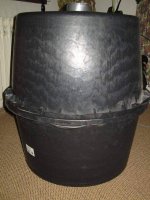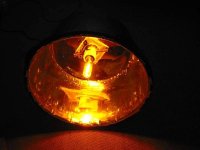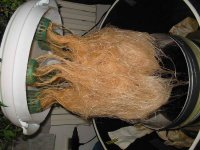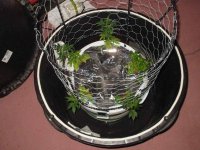-
Happy Birthday ICMag! Been 20 years since Gypsy Nirvana created the forum! We are celebrating with a 4/20 Giveaway and by launching a new Patreon tier called "420club". You can read more here.
-
Important notice: ICMag's T.O.U. has been updated. Please review it here. For your convenience, it is also available in the main forum menu, under 'Quick Links"!
You are using an out of date browser. It may not display this or other websites correctly.
You should upgrade or use an alternative browser.
You should upgrade or use an alternative browser.
I'm in the process of adding 4x24w 12" PLL vertically to my existing cab as we speak! Thanks for the close-ups of your little "cooltubes" so now I can find exactly what I need at the hardware store. Speaking of which... off to the hardware store!
K+
Why not go for higher wattage bulbs like 50 or 55w's?
Why not go for higher wattage bulbs like 50 or 55w's?
I got some free ballasts that only support up to 24w bulbs.
But there may be an issue with them and I may be buying a fulham workhorse 8.
How many 50 or 55w bulbs can I run off of one of those? I've heard some people claim 6 and others claim 3.
Thanks.
twrex
Member
I got some free ballasts that only support up to 24w bulbs.
But there may be an issue with them and I may be buying a fulham workhorse 8.
How many 50 or 55w bulbs can I run off of one of those? I've heard some people claim 6 and others claim 3.
Thanks.
You should be able to run 4 50w bulbs off a wh8.
There are 6 leads and it has a maximum wattage of 220w. While theoretically it could handle 4x55w I have read that drawing the maximum rated power voids the warranty. Personally I'd rather do 6x36w for more points of light, but that's just me.
p.s. if you want to do fewer higher wattage bulbs you might want to look into the wh7, same wattage as the 8 but with fewer leads (3 or 4 I can't remember).
can someone do me a favor and tell me what the hell is so specail about a "PLL" I have been doing industrial lighting for 7 years and been around growing herb for about 10 and I have never herd of this "PLL" ????IMO u get the best results from a full spectrum HPS.
Thanks for ur time.
JDIZZEL
Thanks for ur time.
JDIZZEL
I got some free ballasts that only support up to 24w bulbs.
But there may be an issue with them and I may be buying a fulham workhorse 8.
How many 50 or 55w bulbs can I run off of one of those? I've heard some people claim 6 and others claim 3.
Thanks.
6 if you overdrive, if not, 3.
If you were to get the workhorse 8 (or 7) I'd go with 4 50w bulbs rather than 3 55w's. The lumen difference between a 50w and 55w bulb is like 800, so with 4 50w's you get 200w's and ~16,000lm's, though if you were to use 3 55w's you'd only have 165w's with ~14,400lm's.
can someone do me a favor and tell me what the hell is so specail about a "PLL" I have been doing industrial lighting for 7 years and been around growing herb for about 10 and I have never herd of this "PLL" ????IMO u get the best results from a full spectrum HPS.
Thanks for ur time.
JDIZZEL
You most likely never heard of them as that is not their actual name, its more off a nickname. They are essentially florescent tubes that have been doubled over on themselves back to a 4-pin base used for 2g11 sockets.
This results in higher lumen output, better light distribution and cooler temps than conventional CFL's of similar wattage's. Another distinct advantage over other lighting options is a profile of only ~2" making them ideal for smaller operations. Also, for under a $100USD I can setup a 200w, 16,000 lumen, lighting system using a Fulham Workhorse 7 ballast and four 50w PL-L's.
twrex
Member
can someone do me a favor and tell me what the hell is so specail about a "PLL" I have been doing industrial lighting for 7 years and been around growing herb for about 10 and I have never herd of this "PLL" ????IMO u get the best results from a full spectrum HPS.
Thanks for ur time.
JDIZZEL
I'm going to assume you're being serious and not trolling (it's a little hard to tell) here is what I've learned about them so far.
--------------------------------------------------------
History: Firstly, while I'm not a lighting historian I know that pl-l is a designation that stems from the manufacturer phillips and has become a generic term for these style lamps (like bandaid, q-tip, jell-o, or kleenex for adhesive strips, cotton swabs, gelatin, and facial tissues respectively). These are twin t5 tubed remote ballasted compact fluorescent lamps. I believe they are more popular in europe as industrial lighting. While all have four pins the two most common base styles are the 2g-11 ("german" style straight pin) and the g10q ("japanese" style square pin).
Long version: It is a remote ballast straight compact fluorescent bulb. Better than the twirly cfls by having less internal reflection loss and the remote ballast moves a great deal of the heat outside the plant compartment. Some people prefer fluorescents and the added control which they provide, with regards to spectrum, compared to hps/cmh/whatever. This is due to the ability to swap out lights and mix spectra at a minimal cost. Not to mention they throw off their heat over a larger area than the point source lights (hps/cmh), so it's less of a burn risk for plants, which means plants can be closer to the bulbs.
They also allow for really neat things like the high-pod which I don't think you'd be able to do with any other light type. Mostly it's only of interest to folks who prefer micro grows and don't want to deal with building a full on cool tube, although obviously the vertical versions use t-12 protectors as a precaution.
Also, in the smaller wattage ranges anyhow (<150w), I believe I've read that fluorescents provide more lumens per watt than the other alternatives. There is also added light due to the plant's ability to be closer without being burnt*.
Short version: Different strokes for different folks.
-------------------------------------------------------------------------
I think that about does it, if I missed anything or was inaccurate in any point please feel free to let me know, it's late and I've had a long day.
 Hope that helps.
Hope that helps.*Since lumens are rated at one foot from the light source, the closer the plant is to the source the more light is available. If you have an hps and a pll with a similar wattage input and lumen output but are able to get the plant 3" from the hps and .5" from the pll the plant will receive more light from the pll due to the decreased distance.
high guys, as a PLL'er myself i thought i'd toss this up,
not to refute what you said twrex, but just to show
that others are doing some interesting things with
150HPS's.
that's what makes this community so cool, all the innovative thinking.
not to refute what you said twrex, but just to show
that others are doing some interesting things with
150HPS's.
that's what makes this community so cool, all the innovative thinking.
Attachments
I'm going to assume you're being serious and not trolling (it's a little hard to tell) here is what I've learned about them so far.
--------------------------------------------------------
History: Firstly, while I'm not a lighting historian I know that pl-l is a designation that stems from the manufacturer phillips and has become a generic term for these style lamps (like bandaid, q-tip, jell-o, or kleenex for adhesive strips, cotton swabs, gelatin, and facial tissues respectively). These are twin t5 tubed remote ballasted compact fluorescent lamps. I believe they are more popular in europe as industrial lighting. While all have four pins the two most common base styles are the 2g-11 ("german" style straight pin) and the g10q ("japanese" style square pin).
Long version: It is a remote ballast straight compact fluorescent bulb. Better than the twirly cfls by having less internal reflection loss and the remote ballast moves a great deal of the heat outside the plant compartment. Some people prefer fluorescents and the added control which they provide, with regards to spectrum, compared to hps/cmh/whatever. This is due to the ability to swap out lights and mix spectra at a minimal cost. Not to mention they throw off their heat over a larger area than the point source lights (hps/cmh), so it's less of a burn risk for plants, which means plants can be closer to the bulbs.
They also allow for really neat things like the high-pod which I don't think you'd be able to do with any other light type. Mostly it's only of interest to folks who prefer micro grows and don't want to deal with building a full on cool tube, although obviously the vertical versions use t-12 protectors as a precaution.
Also, in the smaller wattage ranges anyhow (<150w), I believe I've read that fluorescents provide more lumens per watt than the other alternatives. There is also added light due to the plant's ability to be closer without being burnt*.
Short version: Different strokes for different folks.
-------------------------------------------------------------------------
I think that about does it, if I missed anything or was inaccurate in any point please feel free to let me know, it's late and I've had a long day.Hope that helps.
*Since lumens are rated at one foot from the light source, the closer the plant is to the source the more light is available. If you have an hps and a pll with a similar wattage input and lumen output but are able to get the plant 3" from the hps and .5" from the pll the plant will receive more light from the pll due to the decreased distance.
i see now said the blind man. good info and thanks i was intrested to know. thanks for taking the time to put that info together for me.
JDIZZEL
and please dont hate me cause I use HPS LOL
twrex
Member
I don't hate on any methods, like I said, it takes different strokes and everyone is entitled to their favorites. I'm personally a big fan of pl-l and think it's the best thing going for small scale until LED systems become more affordable.
I really like the idea of vertical pl-l and think it has the best of all worlds (for small scale): inexpensive, low power consumption, more even light distribution at different points on the plant, less heat, customizable spectrum.
I really like the idea of vertical pl-l and think it has the best of all worlds (for small scale): inexpensive, low power consumption, more even light distribution at different points on the plant, less heat, customizable spectrum.
oldone
Member
and please dont hate me cause I use HPS LOL
Dont sweat it dude. I think the great strength of our shared hobby is its diversity. Only fools lose sleep over what other people are growing with, I guess we've all seen a few.
Live and learn,
OO
you grow herb or try to grow herb you deserve some love whether it is pll cfl led mh hps or sunlight. We are human we adapt to our enviroment by being intelligent or great mimickers. No hate here just sharing ideas.
You forgot CMH.
IwannatokeNbone
Member
Id luv to do a pl-l grow, i was wondering if u guys are useing like 110 watts with one of theese htg kits, what would a good yeild be, ive got some skill n now how, i guess im wondering if they do really outyeild even a simple t-8 set up?
thx
thx
Tilt
Member
Wild sativas under 110w PL-L
http://www.icmag.com/ic/showthread.php?t=81814&page=1&pp=15
http://www.icmag.com/ic/showthread.php?t=81814&page=1&pp=15
Id luv to do a pl-l grow, i was wondering if u guys are useing like 110 watts with one of theese htg kits, what would a good yeild be, ive got some skill n now how, i guess im wondering if they do really outyeild even a simple t-8 set up?
thx
PLL's will blow T8's out of the water, no comparison.
IwannatokeNbone
Member
PLL's will blow T8's out of the water, no comparison.
weres the pics is what im saying?
ive seen beekas grow here were he ran a 72 watt standard t-8 and got 60 grams from clones, are u guys pulling anywere near a gram a watt with theese lights? im impressed n sold already, im just curious not asking for a justification
Latest posts
-
Australian Dead Head (mullumbimby madness x Neville's haze)?
- Latest: Maria Sanchez
-
-
-
Latest posts
-
Australian Dead Head (mullumbimby madness x Neville's haze)?
- Latest: Maria Sanchez
-
-
-






